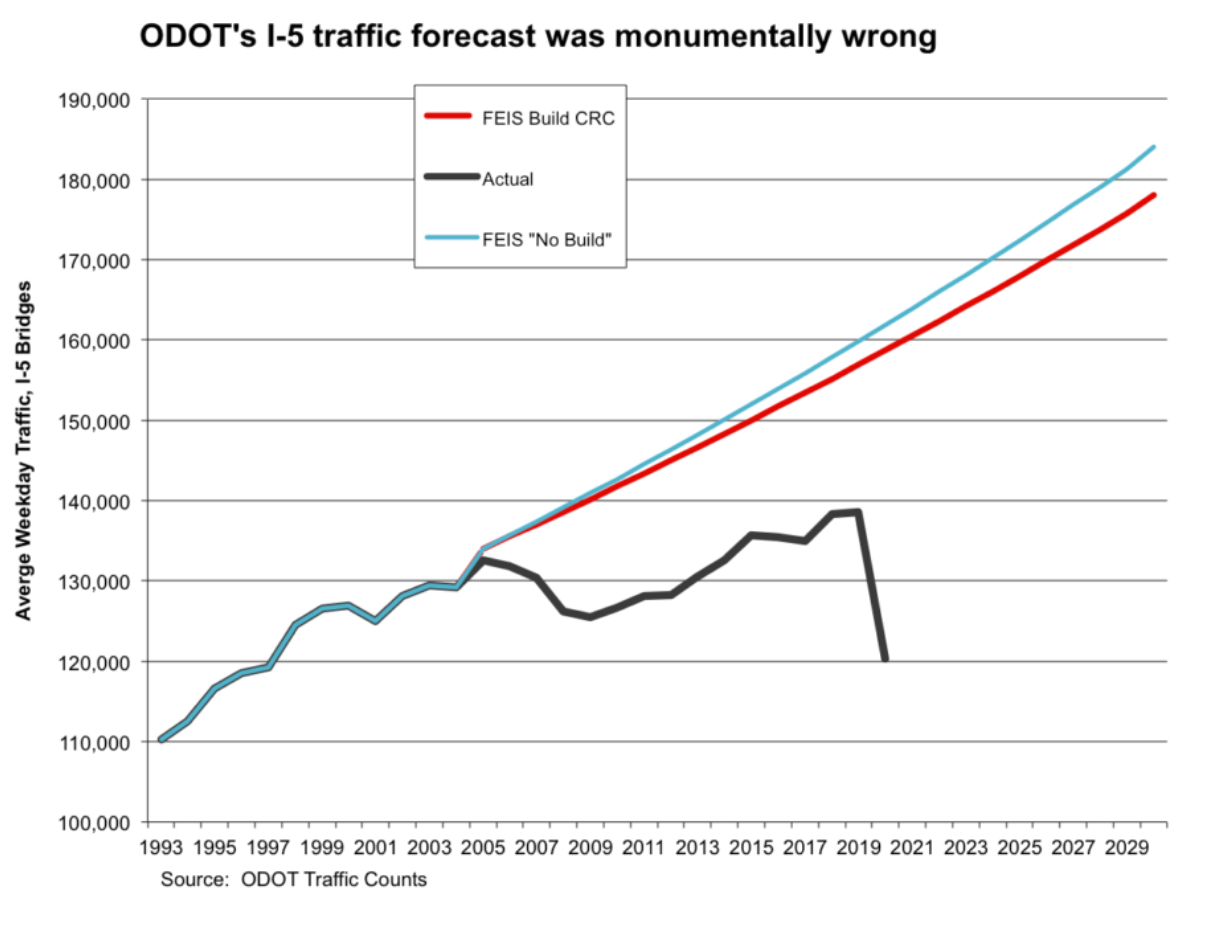We’ve had the document for a week now (all 12,500+ pages). We’re still reading, but here are some initial thoughts to stimulate your review.
We may update this post as we learn more. Comments are open below, so let us know what you think and what you’re reading in the SEIS.
- 20 year old Purpose and Need
- Same six purpose bullets as CRC, from a process started in 2005
- Equity and Climate “lenses” that have been added haven’t had any impact we’ve seen yet other than adding more sections to the EIS
- The “original sin” is bundling congestion with the important objectives of seismic resilience, transit and active transportation
- Traffic Forecasts are unmoored from facilities design
- Repeats error from CRC modeling: traffic and congestion in no build alternative will continue to rise despite the fact that the current facility is constrained. The CRC EIS predicted the “no build” alternative would see 180,000 vehicle crossings daily by 2028. The Draft Supplemental EIS now predicts the “no build” will now see 180,000 vehicles in 2045. Zero learning from history!
- Actual data since CRC forecast proves this point

- If no build VMT forecast is wrong, then all other analyses based on this (air quality, GHG) are wrong as well when compared to the build alternative.
- Actual data since CRC forecast proves this point
- Induced demand does not show up in the index.
- Only actual reference to induced traffic is from a Metro memo on “induced development” (deep in the Transportation Technical Report document) from the CRC project written in 2010
- Takes essentially the same line that ODOT does, induced demand only occurs if land use changes occur (i.e., denies that reduced congestion prompts more people to use a road)
- Makes the assertion that land use patterns already anticipate IBR being completed
- We’d note that in addition to the auxiliary lane(s) the project proposes collector-distributor ramps and lanes on the Vancouver side, and it would seem apparent that these increase capacity
- No meaningful VMT difference between one aux lane and two aux lanes (see induced demand) – fails common sense.
- Impact of tolling is left as an open question between base tolling case and “high toll scenario”. We know the state Transportation Commissions will make the decision on toll rates and suspect they may be a lot more focused on paying off construction bonds than managing demand.
- Suggests that diversion to I-205 due to tolling will be relatively small.
- Totally unintuitive conclusion that variable (by time of day) toll rates will INCREASE peak hour travel, resulting in increased trip times for morning express buses to Portland. We’ve reached out to get a better understanding of this.
- Repeats error from CRC modeling: traffic and congestion in no build alternative will continue to rise despite the fact that the current facility is constrained. The CRC EIS predicted the “no build” alternative would see 180,000 vehicle crossings daily by 2028. The Draft Supplemental EIS now predicts the “no build” will now see 180,000 vehicles in 2045. Zero learning from history!
- Climate
- Touts benefits from green construction methods/materials and reducing GHG from maintenance but acknowledges that main source of GHG (94%) is from traffic on the facility
- Essentially throws in the towel on climate change, saying RCP 2.6 scenario (i.e., high mitigation efforts, keeping warming to 1.5-2.0 ºC) is unlikely (no acknowledgement that this project could be part of why that’s unlikely).

- They are designing the bridge assuming higher CO2 scenarios to withstand frequent temperatures over 100ºF and up to 10 days a year over 105ºF
- Makes claim for a small GHG benefit from 2nd aux lane because congestion is reduced slightly more, the current fig leaf of DOTs: “we’ll help GHG by reducing stop and go traffic”
- Transit
- Acknowledges that LRT capacity is constrained at Rose Quarter, does not propose workarounds to that
- Express bus preferred operation scenario on shoulder of highway
- See above issue with AM express bus delay
- Cumulative Effects
- Temporary cumulative effects (i.e., construction effects) do not mention Rose Quarter construction happening simultaneously. Also no mention of EPA Harbor Cleanup happening at the same time